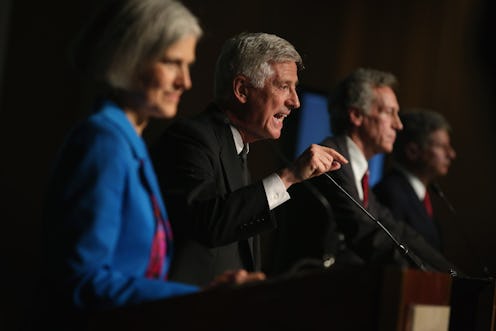News
Why Third-Party Candidates Don't Do Better
American voters in 2016 are not thrilled with the options with which they are being presented. According to a recent poll, current frontrunners Hillary Clinton and Donald Trump have the highest unfavorability ratings of any presidential candidate since 1984. This situation seems ripe for the rise of a candidate not affiliated with either major party. However, it is extremely unlikely that the next president will be anything but a Democrat or a Republican. Why don't third-party candidates perform better in elections, even when the electorate is highly dissatisfied with the main options?
There are many interconnected answers to this question which all come together to make U.S. elections hostile territory for candidates unaffiliated with the two major parties. First, let's consider how the two-party system developed. This happened somewhat naturally based on how the Electoral College votes are allocated (and how lower-level elections are decided as well).
The winner of the most votes in a state is awarded all that states' electoral votes. This is called a winner-take-all system. Only two states allocate electoral votes proportionally. With the winner-take-all setup, two parties tend to develop that roughly represent the views of most of the electorate. Theoretically, they tend to be more moderate than third parties, which theoretically represent the views of smaller pockets.
This two-party tendency is connected to the "spoiler effect." If people vote for a third-party or independent candidate in an election, they risk tipping the election to the more popularly-backed major candidate with whom they agree least. (Think: If Sen. Bernie Sanders launched an independent bid, people who might align more with Clinton than Trump could vote for Sanders and risk tipping the election to Trump.)
That's a worst-case scenario. On the other hand, people may feel that voting for a third-party or independent candidate is simply a "wasted vote," since these candidates supposedly have no chance of winning. We can see how this can become a self-fulfilling prophecy.
But the electorate is becoming more and more disenchanted with the major parties — something evidenced not only by Trump and Clinton's ratings, but by the fact that far more Americans now identify as independent than as Republican or Democrat. In light of this, third-party candidates theoretically could stand a chance, since the underlying premise that the major parties represent the views of most Americans is becoming less and less true. Still, the mentality that they can't, and therefore aren't worth taking seriously, may persist via inertia.
But a persistent societal mentality toward third-party candidates is far from the only thing standing in their way. Institutional barriers exist as well. Media coverage is crucial for campaigns, but how much coverage have you seen of the Green Party's Jill Stein, or of the Libertarian Party's Gary Johnson? If candidates can't get their names and faces and policies out there, they can't drum up support. Part of the reason we know way more about Trump and Clinton than Stein or Johnson is likely that members of the media share the same mentality as many in the public: These candidates just can't win, so why bother covering them?
If you can't make it onto TV or into major publications, then you're not likely to do so hot in the polls. And the Commission on Presidential Debates requires that general election presidential candidates receive at least 15 percent of support in polls in order to earn a spot on the stage. The last non-major-party candidate to pull that off was Ross Perot in 1992.
The reason Perot was able to do so leads us to another obstacle for most third-party and independent candidates, the importance of which cannot be understated: money. Perot was a billionaire who could not only buy himself plenty of media time, but could also afford to fund a good portion of his own campaign. Lacking a solid base of supporters and donors for the reasons already mentioned, and lacking billionaire status, most third-party or unaffiliated candidates can't afford to do so.
An additional financial barrier for third partiers and independents is how the Federal Election Commission allocates federal funds for campaigns. Major-party candidates can get up to $20 million in public grants to run their general election campaigns. Independent candidates are eligible only for a portion based on the ratio between their popular vote percentage to the average percentage of the vote for the major-party runners, and those funds are only made available after the election and if the candidate got at least 5 percent of the vote. Third-partiers are eligible for a portion of funding based on the percentage of the popular vote the party earned in the previous election (which is generally close to zero).
One more institutional barrier for independents and third parties is ballot access. Laws for getting on the ballot differ by state, but they generally require a candidate to either be affiliated with a party the state officially recognizes or to collect a ton of signatures by specified deadlines, which takes time and money. Democratic and Republican candidates are automatically on the ballot, because all states recognize these parties, according to Ballotpedia. Not so for most non-major-party runners in most states.
Though our Democratic and Republican frontrunners aren't winning the national popularity contest, this doesn't necessarily mean that a non-major candidate will emerge as a viable option. A complex and interconnected system of prejudices and institutional barriers reinforce one another to hold them down.
We can't expect this system to be overhauled in the next half year. But we may, with some reason, anticipate the beginnings of such a process, as widespread public dissatisfaction forms cracks in the foundation of the two-party system.
